
A group of volunteers with Maui Medic Healers Hui gather before heading out to help people affected by the fires in Lahaina.
Claire Harbage / NPR
It’s Sunday afternoon at the Kahana boat ramp in West Maui. Until recently this spot was a place mostly to launch boats. Now it’s morphed into a community-run hub where volunteers are working to address both short and long term concerns of all kinds.
Ka'imikila Moraes, an EMT with family ties to Lahaina, has been staffing the site as a volunteer with the grassroots group Maui Medic Healers Hui. "Some people are recovering from burns and so they need their dressings changed," he says, "Others inhaled a lot of smoke either during the fire, or in the immediate aftermath when they went to look for people and belongings, so we do a lot of nebulizer treatments over here, as well."
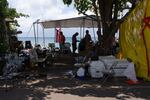
A boat ramp turned a community-run hub, just north of Lahaina, where volunteers are working to address short- and long-term health and wellness needs.
Claire Harbage / NPR
But mostly what he's doing now is helping people deal with trauma. "They just need to talk about it, they need to process. A lot of times what starts as patching up a band-aid on a finger turns into a lot more," Moraes says.
It's a stark difference from the frenetic early days of the crisis.
It's been three weeks since the Lahaina wildfire tore through downtown, killing at least 115 people and leveling 2,000 homes and buildings. As the situation stabilizes, the crisis response to the Lahaina fire is evolving from a sprint to a marathon. Responders at sites like this one are looking beyond the immediate needs of the disaster to the longer-term consequences for the community's health and recovery.
The emergency medical needs that were initially tended to by volunteer groups like the Maui Medic Healers Hui have been reabsorbed by a functioning 911 and the medical establishment. This group — started by Native Hawaiians — is finding its stride in providing culturally competent care. Most of their volunteers have medical training, but "the most important thing we do is spread calm," says Dr. Kalamaoka'aina Niheu, who co-founded the group with Noelani Ahia, an health care worker and indigenous activist with deep family roots in Lahaina.
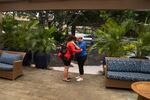
Dr. Kalamaoka'aina Niheu (left) with a member of the Maui Medic Healers Hui team, takes a moment of calm while checking on different locations where their team is deployed near Lahaina.
Claire Harbage / NPR
Talking story: a tool and tradition
One way to spread calm is by talking story — slowing down and making time to connect with others. It's long been part of the culture in Hawaii.
"Talk story is what happens at the grocery store, when you go to pick up something fast and you notice the clerk is talking story with the customer for awhile," says Teri Holter, a social worker and therapist in Maui, and a volunteer with the medic group.
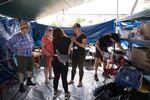
Noelani Ahia (center), an indigenous activist with deep family roots in Lahaina and a co-founder of Maui Medic Healers Hui, talks with volunteers at one of their locations in Lahaina.
Claire Harbage / NPR
It's especially important after this collective trauma, where people may be feeling disconnected, says Tia Hartsock, director of the Office of Wellness and Resilience in the Hawaii governor's office. "Some people have been in severe pain. Some people have lost their family. There's a huge, collective loss of sense of place," she says. "Talk story is our ability as a community to reconnect."
At the Kahana boat ramp, friends and neighbors swing by to talk story. Joseph Ah Puk — a third-generation Lahainan — has two nieces and a brother that lost their homes in the fire. It missed his house by two blocks. He returned to his house on Sunday morning to mow the lawn. "Hard for me to understand how the water can be compromised, because the fire blew downhill," he says, referring to an "unsafe water advisory" issued by the county.
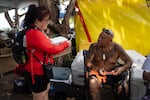
Joseph Ah Puk, a third generation Lahainan, talks with Dr. Niheu at the boat ramp. Ah Puk has two nieces and a brother that lost their homes in the fire. It missed his house by two blocks.
Claire Harbage / NPR
Assessing and mitigating damage will likely take years
There are some early signs that the water could be safe. Dr. Lorrin Pang, the top health official in Maui, says the water advisory was first issued out of an abundance of caution based on water contamination after other wildfires. Water testing results, shared last week, showed tap water still within the EPA standards. While health authorities plan to keep monitoring the levels, Pang is hopeful that as the water system gets repaired it will flush itself out.
Layers of toxic ash are relatively harmless undisturbed — but could lead to serious health concerns, if people start digging through it unprotected. "There's petroleum products, heavy metals and asbestos," buried in the ash, Pang says, which is dangerous for people to breathe and ingest. "If it gets disturbed, it can aerosolize and it can be quite potent."
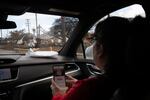
Dr. Niheu looks out the window at some of the destruction while traveling through Lahaina.
Claire Harbage / NPR
But the looming health concern is grief, and the different forms it takes. "There's acute trauma and then there's post-trauma," Pang says. While moving people in need of housing out of shelters and into individual hotel rooms has reduced the risk of some health threats like COVID and norovirus — it's also created the circumstances for experiencing grief and depression in isolation. He says the health department is conducting door-to-door wellness checks in the interim hotel housing several times a week.
"Now that their medical needs and their food, shelter, clothing [needs] are met, they will start to look back and be traumatized by the escape and the loss," Pang says. "Some people deal with it individually, and for others, a community can help."
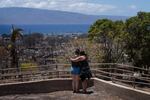
Two women embrace and cry as they look out over a burned area in Lahaina last week.
Claire Harbage / NPR
Dr. Niheu, with Maui Medic Healers Hui, plans to make a consistent sense of community available to people who want it over the long haul. "As Indigenous people, we understand the violence of entry and exit," she says. To make the effort sustainable, they're building up a cohesive group of Maui-based volunteers, led by people from Lahaina — to prepare themselves for a recovery of home and belonging that will take many years.
Copyright 2023 NPR. To see more, visit https://www.npr.org.
